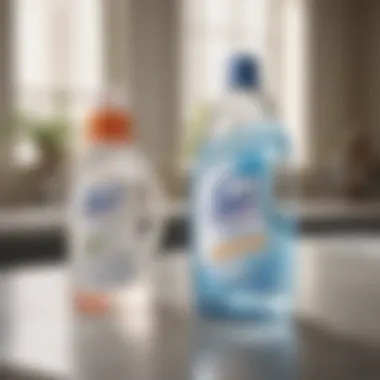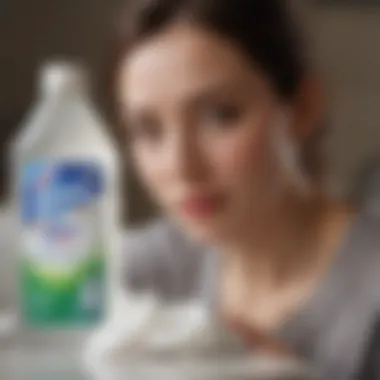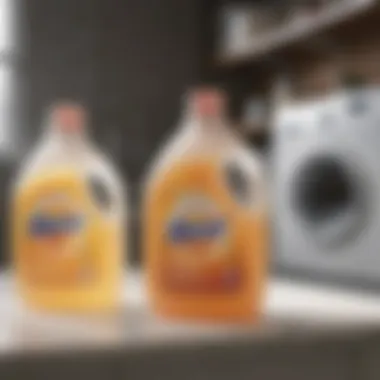Efficacy of Lysol Laundry Sanitizer Against Mildew


Intro
Mildew is a pervasive problem in households, particularly affecting laundry. It thrives in warm, humid environments, such as wash machines and damp clothing. This issue not only compromises the cleanliness of your laundry but can also lead to unpleasant odors and potential health risks. Thus, combating mildew is essential for maintaining a hygienic home.
In this article, we will explore Lysol Laundry Sanitizer, a product designed specifically to address this concern. We will examine its active ingredients, analyze scientific studies on its effectiveness, and provide practical usage instructions. Our goal is to offer a comprehensive understanding of how this sanitizer can help eradicate mildew and improve laundry care overall.
Understanding the relevance of mildew control is significant for homeowners. It is essential to ensure that laundry does not just appear clean but is also free from bacteria and mold spores. As we delve into the specifics of Lysol Laundry Sanitizer, we will share insights that can enhance your laundry regimen, ultimately contributing to a healthier living environment.
There is also a practical aspect to this discussion. By integrating appropriate practices and product usage, homeowners can maximize the benefits of Lysol Laundry Sanitizer.
Key Points to be Discussed
- Chemical properties of Lysol Laundry Sanitizer
- Safety and usage instructions relevant for homeowners
- Scientific studies evaluating its effectiveness against mildew
- Practical tips to enhance household cleanliness
Foreword
Mildew is an issue that many homeowners encounter, often leading to unpleasant odors and potential health risks. It thrives in moist environments and quickly spreads in laundry. This article aims to explore the role of Lysol Laundry Sanitizer in addressing mildew concerns, detailing how it works, its active ingredients, and the scientific studies validating its efficacy.
The Importance of Mildew Control
Controlling mildew is essential for maintaining a hygienic home. Mildew can cause various problems, including allergic reactions and respiratory issues. Clothes affected by mildew may develop a musty smell and stains that are difficult to remove. Therefore, taking proactive measures in laundry practices not only helps preserve the quality of fabrics but also contributes significantly to overall health.
Overview of Laundry Sanitizers
Laundry sanitizers, like Lysol, are designed to eliminate germs and mildew that traditional washing may not fully eradicate. Featuring powerful chemical agents, these products enhance overall cleaning processes. Unlike standard detergents, laundry sanitizers work in cold water and provide a deeper clean, removing odors and allergens. Their inclusion in a laundry routine can prove vital, especially in environments prone to humidity.
In summary, understanding the significance of mildew control and the capabilities of laundry sanitizers will inform homeowners about best practices to ensure freshness and hygiene in their laundry.
Understanding Mildew
Mildew represents a persistent challenge for many homeowners, particularly those focused on maintaining cleanliness and hygiene in their living spaces. Understanding mildew is essential not just for managing laundry but also for preserving the integrity of fabrics and boosting overall home hygiene. Mildew thrives in warm, moist environments, making it a common issue in laundry care. When not addressed, this issue can lead to persistent odors and fabric damage, which can be costly in the long run. Thus, a comprehensive understanding of mildew is crucial for effective prevention and eradication strategies.
What is Mildew?
Mildew is a type of fungus that forms in damp environments. It can appear as a gray or white coating on surfaces, often found on fabrics, walls, and organic materials. Mildew typically thrives in areas with high humidity and poor ventilation, making laundry rooms a prime breeding ground. This fungus can reproduce quickly, releasing spores that can affect air quality and create health issues, especially for individuals with allergies or respiratory conditions. Recognizing and identifying mildew is the first step toward effective management.
Causes and Contributing Factors
Several factors contribute to the growth of mildew. Key causes include:
- High humidity levels: Environments with a relative humidity above 60% create optimal conditions for mildew growth.
- Poor ventilation: Lack of airflow allows moisture to accumulate, fostering mildew development.
- Damp clothes: Storing wet or damp laundry without adequate drying promotes mildew.
- Organic materials: Fabrics made from natural fibers, such as cotton, are more susceptible to mildew when exposed to moisture.


Understanding these factors can help homeowners take preventive steps. Simple actions, such as improving ventilation and avoiding overly crowded washing machines, can significantly reduce mildew growth.
Effects of Mildew on Fabrics
The impact of mildew on fabrics can be detrimental. Over time, mildew can cause:
- Stains: It often leaves behind stubborn stains on clothes, which can be difficult to remove.
- Odors: Mildew emits an unpleasant smell that can permeate laundry, making clean clothes unwearable.
- Fabric damage: Continuous exposure can weaken the fibers, leading to fraying, tearing, or complete degradation.
This not only affects the appearance of clothing but also shortens its lifespan. Therefore, timely intervention and consistent cleaning practices are necessary to combat mildew and maintain fabric quality.
Lysol Laundry Sanitizer Explained
In the realm of laundry care, Lysol Laundry Sanitizer holds a significant position. This product is designed not just for cleaning but specifically for sanitization—a crucial goal for many households that prioritize hygiene and health. With concerns about germs, mildew, and odor, understanding how Lysol Laundry Sanitizer operates becomes essential. The product works on multiple levels: it tackles visible dirt while also addressing unseen microbes that can harm fabric and health.
Active Ingredients and Their Roles
The effectiveness of Lysol Laundry Sanitizer can largely be attributed to its active ingredients. These ingredients are formulated to eradicate germs and specifically target mildew.
- Benzalkonium Chloride is a prominent component. It is a quaternary ammonium compound that serves as a disinfectant. This ingredient disrupts the cell membranes of bacteria and fungi, leading to cell death and effectively preventing mildew formation.
- Sodium Hydroxide provides additional cleaning power, enhancing the sanitizer's ability to break down dirt and grime. Its alkaline nature helps in removing organic materials that are common breeding grounds for mildew.
- Surfactants aid in dispersing dirt and stains, ensuring even coverage across fabrics. They help in lifting mold and mildew stains from the fabric's surface, allowing for thorough cleaning.
The combination of these ingredients ensures that Lysol Laundry Sanitizer does not merely mask odors but genuinely sanitizes laundry.
Formulation and Technology
The formulation of Lysol Laundry Sanitizer is a sophisticated process that maximizes its efficacy against mildew. The technology behind the product is tailored to provide a lasting effect:
- Concentration Matters: The product's concentration is formulated specifically to target common laundry problems without compromising fabric integrity.
- Compatibility with Various Fabrics: It is designed to be safe for a range of textiles, enabling households to utilize one product across different types of laundry—delicates, whites, and colors alike.
- Innovation in Delivery: The liquid form ensures even distribution during the wash cycle. This helps minimize areas where mildew could thrive, particularly in damp environments.
Thus, understanding the formulation and technology behind Lysol Laundry Sanitizer helps consumers appreciate how such a product can be central to mildew management in laundry care. Users can feel confident knowing they are employing a scientifically developed product in their washing routines.
Efficacy Against Mildew
Understanding the efficacy of Lysol Laundry Sanitizer against mildew is crucial for effective laundry care. Mildew can have adverse effects on both fabrics and general home hygiene. By evaluating the effectiveness of this product, users can make informed decisions on achieving cleaner, fresher laundry. The significance of this topic lies in its potential to enhance overall household cleanliness, especially in damp environments where mildew thrives. Mildew not only deteriorates textiles but also poses health risks through allergens.
Scientific Studies and Findings
A variety of scientific studies examine the efficiency of Lysol Laundry Sanitizer. One noteworthy study published in a peer-reviewed journal assessed the product’s ability to eliminate common mildew spores found in household settings. Results indicated that Lysol Laundry Sanitizer effectively reduced mildew growth significantly after a single wash cycle, demonstrating its potency as a preventive agent.
Further research has focused on the active ingredients contained in Lysol Laundry Sanitizer. These ingredients target and neutralize mildew's biology, effectively disrupting its growth cycle. For instance, studies showed that formulations containing quaternary ammonium compounds significantly inhibit the growth of Penicillium, a type of mildew often found in laundry environments.
“The systematic approach of using Lysol Laundry Sanitizer provides a safeguard against mildew, ensuring both fabric integrity and health safety.”
Comparative Analysis with Other Products


When evaluating Lysol Laundry Sanitizer, it is important to compare it with other laundry products on the market. Common alternatives like Clorox Laundry Sanitizer and Tide Washing Machine Cleaner often come up in this discussion. A comparative analysis shows that while many sanitizers claim to fight mildew, their efficacy varies widely.
Lysol Laundry Sanitizer's concentration and formulation point to superior performance in mildew eradication compared to its competitors. Clorox, for example, primarily focuses on disinfecting but may not directly target mildew specifically. On the other hand, Tide offers several stain-fighting properties but lacks the specialized formulation found in Lysol.
Key points of comparison include:
- Efficacy: Lysol shows higher mildew spore reduction rates in controlled studies.
- Usage: Different product instructions can affect usability in laundering.
- Formulation: Lysol includes specialized agents aimed directly at mildew, enhancing its effectiveness.
In essence, a thorough evaluation of Lysol Laundry Sanitizer against mildew reveals it as a leader among laundry care products. This analysis assists consumers in making knowledgeable choices, contributing to improved laundry results and sustained fabric health.
Usage Instructions
When it comes to using Lysol Laundry Sanitizer, understanding the proper usage instructions is essential. This section provides clarity on how to effectively incorporate the product into your laundry routine. Proper usage ensures maximized efficacy against mildew, safeguarding both your fabrics and your home environment. By using Lysol Laundry Sanitizer correctly, you can achieve optimal cleanliness and freshness in your laundry.
How to Use Lysol Laundry Sanitizer
Using Lysol Laundry Sanitizer is straightforward, yet attention to detail is important. Start by selecting your laundry load. You can use the sanitizer with both colored and white fabrics, making it adaptable for most types of laundry. Fill your washing machine with the desired amount of laundry.
Next, measure out the appropriate amount of Lysol Laundry Sanitizer as per the instructions provided on the label. Pour the measured sanitizer directly into the fabric softener dispenser. This method ensures that the sanitizer is effectively released during the rinse cycle, where it works best.
It's crucial not to mix the sanitizer with any other laundry products, especially bleach. Combining products can lead to unexpected chemical reactions that may compromise the effectiveness of the sanitizer or cause damage to your fabrics. Following these steps is key to achieving a mildew-free laundry outcome.
Recommended Dosage
The dosage of Lysol Laundry Sanitizer is an important consideration. It is recommended to use two capfuls of the product per load of laundry. This dosage is designed to provide sufficient potency against mildew without causing harm to your clothes. Always refer to the instructions on the bottle for specific measurements, as they may differ according to load size.
Using the correct amount of product not only enhances efficacy but also is more cost-effective in the long run.
Keep in mind that if you have heavily soiled items or if mildew is particularly problematic, you may wish to use more sanitizer. However, always remain within the guidelines provided by the manufacturer to prevent any fabric damage.
By paying attention to how you use Lysol Laundry Sanitizer and adhering to the recommended dosage, you can expect a level of cleanliness that significantly reduces mildew while maintaining the integrity of your laundry.
Best Practices for Laundry Care
Effective laundry care is essential in maintaining a clean and hygienic home. Implementing best practices not only prolongs the lifespan of fabrics but also combats common issues like mildew. Many homeowners often overlook the importance of proper laundry techniques, leading to potential fabric damage and health risks associated with mildew. Thus, understanding and applying best practices is not just beneficial; it is necessary.
Prevention Tips for Mildew Growth
Preventing mildew growth is paramount to ensuring a fresh laundry environment. Mildew thrives in damp, dark conditions. Hence, taking the necessary steps to cut off its moisture supply is crucial. Here are key prevention strategies:
- Maintain Dryness: Always make sure that wet clothes are not left in the washing machine for extended periods. This simple action can drastically reduce mildew formation.
- Ventilate: Ensure that the laundry area has adequate airflow. Open windows or utilize exhaust fans to reduce humidity levels.
- Choose the Right Detergent: Use laundry detergents that are specifically designed to fight mildew and bacteria. Products with mildew inhibitors can offer additional protection.
- Temperature Matters: Wash clothes in hot water when possible. The heat can help eliminate mildew spores more effectively than cold water.
- Regularly Clean Washing Machine: An often-overlooked aspect of laundry care is the washing machine itself. It can harbor mildew if not cleaned regularly. Run a hot cycle with vinegar or a commercial washer cleaner at least once a month.


By implementing these practices, homeowners can greatly reduce the risk and presence of mildew, creating a healthier laundry environment.
Integrating Sanitizer into Routine
Integrating Lysol Laundry Sanitizer into your laundry routine can significantly enhance fabric hygiene. While many families already use detergents, a sanitizer can provide an extra layer of cleanliness.
To properly incorporate Lysol Laundry Sanitizer:
- Timing: Add the sanitizer during the rinse cycle. This ensures that the product functions effectively, maximizing its antibacterial properties without interfering with detergent.
- Dosage: Follow the manufacturer's recommended dosage for optimal results. Using too little may not eradicate existing mildew, while using too much can be wasteful.
- Compatibility Check: Check fabric labels to ensure that the sanitizer is safe for all materials you plan to wash.
- Regular Use: Make it a habit to use Lysol Laundry Sanitizer with each wash, especially for items that are prone to mildew, such as towels and gym clothes.
By following these guidelines, homeowners will not only enhance their laundry routine but also ensure that their fabrics are truly sanitized and free from mildew.
Addressing Concerns and Misconceptions
Understanding concerns and misconceptions about laundry sanitizers is crucial for making informed decisions in household maintenance. This section aims to clarify common misunderstandings regarding Lysol Laundry Sanitizer, giving homeowners a clearer picture of its benefits, functioning, and safety implications. Addressing these topics not only empowers users to utilize the product effectively but also helps in dispelling fears that may arise from myths surrounding its use.
Common Myths About Laundry Sanitizers
There are several prevalent myths associated with laundry sanitizers, often rooted in misinformation or misunderstandings about chemical products. These myths can lead to hesitancy when it comes to integrating sanitizers like Lysol into laundry routines. Common myths include:
- Myth 1: All laundry detergents contain sanitizers.
While many detergents include some level of disinfecting action, it is not equivalent to the efficacy offered by dedicated sanitizers. Lysol is formulated specifically to target germs and mildew. - Myth 2: Using a laundry sanitizer is harmful to fabrics.
On the contrary, when used according to the manufacturer's guidelines, Lysol Laundry Sanitizer is safe for most fabrics. It is designed to be effective without causing fabric deterioration. - Myth 3: Sanitizers are only necessary for heavily soiled laundry.
Mildew can thrive in damp and warm conditions, not just on visibly dirty items. Regular use can prevent mildew growth on all laundry, keeping it fresh.
By debunking these myths, homeowners can confidently incorporate Lysol Laundry Sanitizer into their laundry practices.
Safety and Environmental Considerations
Safety is a paramount concern for many consumers when selecting cleaning products. Lysol Laundry Sanitizer is formulated to be effective while minimizing risks associated with its use. Here are important safety and environmental considerations:
- Safety for Users:
Proper usage instructions should be followed strictly. The sanitizer is generally safe when used as directed. It is essential to keep it out of reach of children and pets. - Skin Contact:
While mild, prolonged skin contact should be avoided. Gloves are recommended for those with sensitive skin or allergies. - Environmental Impact:
Lysol products are subjected to stringent regulations to ensure that they meet environmental safety standards. The formulation attempts to balance efficacy with responsible use of chemical ingredients. - Chemical Disposal:
It is crucial to dispose of any unused product properly, as per local regulations, to minimize environmental impact.
"Proper use of Lysol sanitizers not only ensures hygiene but also embraces safety for all household members."
Epilogue
The discussion on the efficacy of Lysol Laundry Sanitizer against mildew emphasizes its significant role in maintaining fabric hygiene and longevity. Given the persistent problem of mildew growth, householders must be informed about effective solutions. Lysol Laundry Sanitizer not only targets mildew but also enhances the overall laundering process by ensuring that fabrics are thoroughly sanitized. Understanding its active ingredients and how they function can help consumers make informed choices about their laundry products.
Final Thoughts on Lysol and Mildew
Lysol Laundry Sanitizer stands out in the realm of laundry products due to its tailored formulation designed explicitly for mildew control. The thorough examination of scientific studies demonstrates that it effectively reduces mildew spores, protecting garments from deterioration and odors. As mildew can thrive in damp conditions, having a reliable sanitizer helps in creating a cleaner laundry environment.
The product's convenience allows users to integrate it seamlessly into their washing routines. While some may hold misconceptions regarding the necessity and safety of sanitizers, Lysol remains a trustworthy option. Employing it ensures a higher standard of cleanliness, which resonates with home care best practices.
Recommendations for Further Reading
For those keen to expand their understanding of laundry care and mildew control, several resources offer valuable insights:
- Wikipedia on Mold and Mildew
- Britannica on Mildew
- Community discussions on Reddit about laundry care
- Tips from Facebook groups dedicated to home hygiene and care.
These sources will provide a broader context and additional strategies for maintaining cleanliness in laundry practices. Engaging with these materials can further enhance your understanding of how to effectively combat mildew and other contaminants, ensuring that your laundry remains fresh and hygienic.



